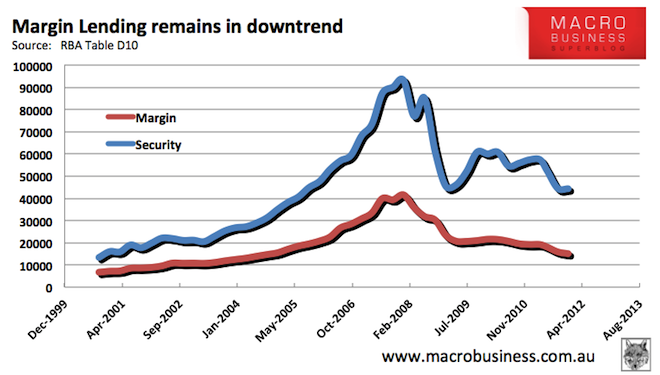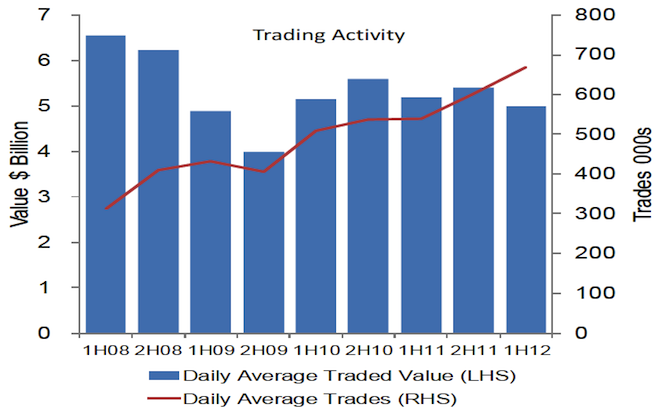Three interesting releases this week that in context provide an insight into the sentiment around Australian stock market. Let’s have a closer look.
One of the key factors in a new bull market in stocks, just like property, is a propensity for investors to borrow more on expectation of higher earnings – alongside a move to higher price/earnings ratio premia, reversal from a lower interest rate environment and the “lazy balance sheet” theory.
Given the RBA’s recent decision to hold on interest rates – a possible reversal, but not confirmed until 1 or 2 subsequent rate rises – and that corporate balance sheet’s are indeed “lazy” with low gearing ratios, the first sub-factor needs closer attention.
Yesterday the Reserve Bank (RBA) released its quarterly Margin Lending (D10) tables, figures I have watched closely here at MacroBusiness.
The December 2011 quarter nominal value of margin loans outstanding – $15 billion, continues the outright deleveraging in margin lending, where the previous quarter was $15.9 billion. This is the lowest level since the December 2004 quarter (approx. $15.5 billion), after rising to the heady heights of over $41.5 billion in the December 2007 quarter.

The market value of the security backing the lending (note: not the market itself, but the aggregate of the securities borrowed) has stabilised over the quarter, but still at December 2008 levels, as the secular bear market in Australian stocks rolls on.
Further, the number of client accounts continues to shrink, down by 4000, although thankfully margin calls per day have halved since the terrible September quarter of last year.
I do note that the absence of evidence of rising margin lending and number of investors doing so is not necessarily evidence of absence of bullish sentiment, as the move towards CFD (Contracts for Difference) and other products may obscure this analysis.
With that in mind, let’s move on to the next release, covered by Morningstar earlier this week:
The “Investment Trends Second Half 2011 Australia Online Broking Report” surveyed more than 7000 active share traders between November and December.
Australian investors who trade shares online have been beset by levels of fear and poor sentiment last seen in 2008 when the global financial crisis (GFC) hammered markets, an Investment Trends report found. The survey shows investors have felt the negativity since August 2011.
“The sentiment is really, really low. People are scared and they’ve given up as capital gains expectations have also collapsed,” Investment Trends senior analyst Pawel Rokicki said.
“Expected market returns for the following 12 months (excluding dividends) fell from 13 per cent in December 2009 to 8 per cent a year later and a mere 2 per cent in December 2011. But there is light at the end of the tunnel – the vast majority of share traders see Australian shares as undervalued,” the report read in part.
Arguably a very small sample size, this report does provide some clear insight into the sentiment around markets. No surprise that when the ASX200 fell 20% that sentiment collapsed, and contrarians can point to the extreme low in bullish sentiment as a sign of an imminent turnaround.
However the key words are “capital gains expectations” – i.e the propensity to bid higher premiums for earnings have fallen, even though, as the report states, most find Australian shares to be undervalued.
The report goes on to state:
The report found that the number of people who had actively traded online rose by 20,000 between May and December 2011. The number of people who traded online at least once in 2011 stood at 630,000, down from a recent peak of 650,000 in May 2010.
“Against that backdrop, it’s actually quite encouraging that the number of online share traders has increased, but having said that the volumes are still very low,” Rokicki said.
This mirrors the margin lending stats, as to be expected when markets peak and then move sideways – only the canny traders usually stay on board a sideways market and past the March 2009-May 2010 bear market rally, it appears that mainstream investors have been absent.
A third piece of the jigsaw was buried in the ASX Ltd (ASX) interim report from yesterday:

This chart plots the daily average value of shares traded on the ASX, which has fallen from a peak in early 2008 of $6.5 billion to just on $5 billion (note that the Austrlaian population in that period rose by over 1 million people), and again there was a substantial uptick during the March 2009-May 2010 bear market rally.
Of interest however is the amount of trades – more than doubling since the GFC, with the average trade size now a little over $7000 – down over 23% in the last quarter alone.
Are we seeing, as in currency markets and the US , the fall of the retail investor and the rise of the robot HFT algo’s?